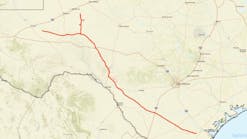Big Oil can be successful in shale but it requires a relentless focus on improving productivity and an ability to be nimble, said Rod Skaufel, president of North American shale for Melbourne-based BHP Billiton.
Speaking to a press briefing in Houston on Monday, Skaufel said BHP was best known for its ability to execute complex deepwater developments when it entered into US shale in 2011.
BHP’s first major shale acquisition was Chesapeake Energy Corp.’s assets in the Fayetteville shale in Arkansas for $4.8 billion, followed by a $12.1 billion merger with Eagle Ford shale pioneer Petrohawk Energy.
Skaufel said shale requires a different business approach from operating in deepwater and the company had to climb a steep learning curve. “We had to rethink how we work,” he said.
“Our skillset clearly was offshore deepwater and [shale] just requires a different mentality. It requires a more fit-for-purpose oversight model,” he said. Operating in shale, calls for an ability to be nimble and make decisions relatively quickly.
The timeline for bringing a new deepwater development online in the Gulf of Mexico can take 7-10 years and can call for developing a massive offshore production platform. By contrast, it takes BHP an average of 20 days to drill and complete a well in its Black Hawk area in the Eagle Ford shale, which is not conducive to the same laborious approval process used in offshore projects.
“The first year was tough. Our costs were high, our costs were higher than Chesapeake’s or Petrohawk’s initially,” Skaufel said. “We’re cost competitive now, but it was a tough, tough journey.”
BHP is constantly looking for ways to become more efficient. In the Eagle Ford shale, productivity increases are driven by a continuous performance benchmarking system called the pacesetter program. The program involves breaking down a well into sections of a hole—surface casing, production casing, and horizontal section—then looking across the company’s rig fleet to see which rig drilled each section the fastest. Then, attempting to replicate that performance across BHP’s operations.
“Shale is about continuous improvement,” Skaufel said. “You want your next well to be better than the last one.”
Under Skaufel’s leadership, BHP’s shale arm has become a formidable player in the North American shale business. The company now holds leading positions in the Eagle Ford shale and Permian basin in Texas, the Fayetteville shale, and the Haynesville shale in Louisiana.
Onshore shale now accounts for 42% of the BHP’s global oil and gas production of 670,000 boe/d.
The company has also expanded its shale workforce. Seven internal personnel worked on shale when BHP acquired Chesapeake’s Fayetteville assets in 2011, and 100 employees were gained in the acquisition. Now, Skaufel said, BHP’s shale workforce numbers more than 2,000 and the company earlier this year broke ground on a 30-story office tower in Houston.
BHP’s shale arm is now focused on the liquids-rich Eagle Ford shale. The company is dedicating $3.0 billion of its $3.9 billion budget for the onshore US to the Eagle Ford in fiscal year 2014, which began on Jul. 1.
Seventeen of the 25 rigs the company has working in the onshore US are in the Eagle Ford. Net production from the play is averaging 170,000 boe/d. Activity is focused on the company’s Hawkville area, which covers 250,000 net acres in LaSalle, McMullen, and Live Oak counties; and the Black Hawk area, which covers 70,000 net acres in DeWitt and Karnes counties. Drilling costs in Black Hawk are just above $4.0 million/well.
Skaufel’s background in petroleum reservoir engineering is evident in his leadership approach, which emphasizes investment in diagnostics to validate to reservoir models and gather insight. In the Eagle Ford, the company is using microseismic and production logging to guide efforts to get a more uniform distribution of fractures in its horizontal laterals.
The efforts are paying off. BHP has found that it can increase the estimated ultimate recovery of its Eagle Ford wells 20-60% by improving the vertical proppant coverage in its fracs and frac conductivity. “There’s some really high-end technical work being done in our teams,” Skaufel said.
BHP research has also found that emphasis on high initial production rates is misleading. Analysis of hundreds of Eagle Ford wells found that those with the highest initial production rates do not necessarily yield the greatest production during their first 2 years online. “There is lots of talk about IP rates. IP is not the game. Sustainable [production] rate is the game,” Skaufel said.
The company is also eying the potential of the Eagle Ford shale in Mexico. The country recently passed reforms that will open up its energy sector to private investment for the first time in 75 years. Work to establish a framework for private participation is ongoing, and the government is targeting June 2015 for the first bid round.
“We’re going to go slower rather than faster,” Skaufel said of the company’s efforts to evaluate opportunities in Mexico. “Obviously, we have security concerns across the border, but it’s something that, clearly we’re looking at.”

